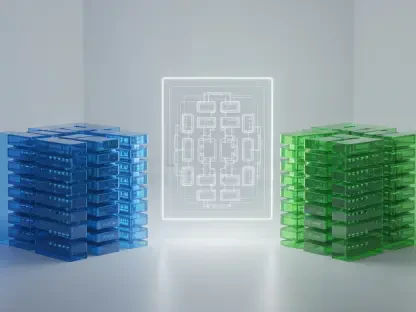In the dynamic and rapidly evolving fields of deep learning and machine learning, the ongoing debate between TensorFlow and PyTorch remains one of the most hotly contested topics. These two frameworks have become industry standards and are extensively employed by researchers and engineers across various domains. While TensorFlow and PyTorch possess some similarities in terms of core functionality, they also boast distinct features that cater to different needs and use cases. This article delves into the strengths, weaknesses, and key differences between TensorFlow and PyTorch to discern which framework is better suited for specific applications.
Introduction to TensorFlow
Developed by Google and launched in 2015, TensorFlow quickly became an industry heavyweight by providing a powerful and flexible platform for deploying machine learning models. Known for its robust support for distributed computing and production-level deployment, TensorFlow is optimized for a wide range of hardware settings, including CPUs and GPUs. Its versatility and efficiency have facilitated its widespread use in both research and enterprise settings.
TensorFlow’s comprehensive ecosystem includes several key components that enhance its functionality. One such component is Keras, a high-level neural networks API that simplifies the process of building and training deep learning models. Another is TensorFlow Lite, designed specifically for mobile and embedded device deployments, allowing models to run on devices with limited computational resources. TensorFlow’s ability to scale efficiently and its extensive set of tools make it particularly popular among large enterprises and those seeking to deploy machine learning models at scale. With its robust support for various platforms, TensorFlow remains a critical tool in the field of machine learning.
Introduction to PyTorch
Introduced in 2016 by Facebook’s AI Research lab (FAIR), PyTorch has garnered a significant following due to its flexibility, ease of use, and dynamic computation graph approach. Unlike TensorFlow’s static graph architecture, PyTorch employs dynamic graphs, enabling developers to build computation graphs on-the-fly as operations are executed. This on-the-fly construction allows for more intuitive model development and debugging, making it exceptionally well-suited for research and rapid prototyping.
PyTorch’s dynamic computation graphs provide developers the agility to make real-time adjustments and experiment freely without the constraints of pre-defining the entire model structure. This flexibility is a key reason why PyTorch has become the preferred framework for academic research and developers favoring innovation and adaptability. Additionally, PyTorch integrates seamlessly with the Python ecosystem, enabling developers to leverage the rich array of Python libraries and tools, thereby streamlining the machine learning development process. With robust GPU support, PyTorch has solidified its position as a favorite among researchers and developers focused on cutting-edge work in machine learning.
Key Differences Between TensorFlow and PyTorch
A fundamental difference between TensorFlow and PyTorch lies in their approach to computation graphs, which are the underlying structures that represent the mathematical operations performed by a neural network. TensorFlow (prior to version 2.0) relied on a static computation graph, where the graph is defined once and executed thereafter. This method allows for optimization and better deployment since the entire computation can be pre-planned and executed efficiently; however, it requires developers to define the entire model upfront, complicating the debugging and experimentation processes.
In contrast, PyTorch uses dynamic computation graphs, also known as define-by-run, meaning that the graph is built progressively as the model executes. This on-the-fly construction makes PyTorch significantly more flexible and easier to debug. Developers can change computations during runtime and see immediate effects, which is extremely helpful during the experimental and development phases. This key difference underscores why PyTorch is favored in research settings where constant iteration and real-time adjustments are essential.
Ease of Use and Learning Curve
PyTorch is often lauded for its ease of use, particularly for beginners, due to its dynamic nature and compatibility with standard Python debugging tools. The define-by-run approach simplifies understanding, allowing developers to follow the computational flow in familiar Python constructs. This user-friendly attribute makes PyTorch ideal for rapid prototyping, experimentation, and iterative development of machine learning models.
On the other hand, TensorFlow has historically presented a steeper learning curve. Prior to TensorFlow 2.0, its static computation graph approach added complexity to model building and debugging, posing challenges for newcomers. Despite these challenges, the integration of Keras in TensorFlow 2.0 significantly improved the user experience, making it more accessible. Extensive documentation, tutorials, and community support mitigate some learning difficulties, but TensorFlow’s comprehensive feature set still requires a higher initial learning investment compared to PyTorch.
Performance and Scalability
In terms of performance and scalability, TensorFlow often holds a competitive edge, particularly in production deployment scenarios. Its static graph execution is highly optimized for performance, making it suitable for deployment across diverse devices, including mobile phones, edge devices, and cloud platforms. The static nature facilitates pre-optimization, enabling TensorFlow to execute efficient and high-performing models in production environments.
While PyTorch excels in rapid prototyping and experimentation, it has sometimes been perceived as less optimized for production. However, recent advancements like TorchServe and integration with platforms such as ONNX have enhanced PyTorch’s scalability and production readiness. These additions make PyTorch more viable for large-scale deployment and offer improved support for distributed training. Despite these improvements, TensorFlow retains a strong position in production environments due to its mature tools for deployment and scalability.
Deployment and Production Readiness
When it comes to deployment and production readiness, TensorFlow was designed with these exact needs in mind, giving it an inherent advantage. TensorFlow Serving provides sophisticated tools for seamless machine learning model deployment in production environments. Additionally, TensorFlow Lite ensures that models can efficiently operate on mobile and embedded devices, extending TensorFlow’s reach to a broader range of applications. TensorFlow Extended (TFX) further enhances the ecosystem by offering a comprehensive suite for managing the ML pipeline, including data validation, model monitoring, and deployment.
PyTorch has made notable strides to match TensorFlow’s production capabilities with tools like TorchServe and its support for ONNX. However, these tools are relatively newer and less mature compared to TensorFlow’s established ecosystem for deployment and production management. Consequently, while PyTorch is catching up, TensorFlow remains the preferred choice for enterprises focused on building production-ready systems due to its extensive and proven deployment features.
Community and Ecosystem
Both TensorFlow and PyTorch benefit from large, active communities that provide extensive support through forums, tutorials, and research papers. TensorFlow’s longer presence in the market has fostered a more mature ecosystem, featuring additional libraries such as TensorFlow Lite for mobile deployments, TensorFlow Hub for reusable machine learning modules, and TensorFlow.js for machine learning in JavaScript environments. This mature and diverse ecosystem enables developers to address a wide range of needs and applications within TensorFlow.
On the other hand, PyTorch has gained substantial momentum within the research community, primarily due to its ease of use and flexibility. Many of the pioneering research papers and advancements in machine learning are often implemented in PyTorch first, reflecting its strong adoption among researchers. This thriving research-focused community contributes to the framework’s rapid evolution and ensures continuous innovation, which is a key attraction for academics and developers working on cutting-edge projects.
Choosing the Right Framework
Deciding between TensorFlow and PyTorch involves considering the specific needs and goals of the project in question. TensorFlow is highly suited for building large-scale machine learning systems that need to excel in production environments. Its scalability, robust deployment options, and comprehensive ecosystem offer the necessary tools and libraries to develop, train, and deploy machine learning models effectively. For enterprises seeking a well-established framework capable of managing extensive machine learning operations, TensorFlow is the ideal choice.
In contrast, PyTorch’s dynamic computation graph and user-friendly design make it an excellent choice for research and rapid model prototyping. The framework allows for agile experimentation, enabling researchers to adapt and refine models quickly. Additionally, its intuitive integration with the Python ecosystem makes it accessible for beginners and those who prioritize ease of use. For academic research, innovative projects, and teams that require swift development cycles, PyTorch is a compelling option.
Ultimately, both TensorFlow and PyTorch offer distinct advantages, and the choice between them should be guided by the project’s specific requirements and the team’s expertise. Projects that demand high performance and scalability in production are best served by TensorFlow, while those focused on research and prototyping may find PyTorch more suitable. Both frameworks are continuously evolving, incorporating new features and improvements, ensuring they remain valuable tools in the machine learning community.
Additional Insights
In the ever-changing and fast-growing fields of deep learning and machine learning, the debate between TensorFlow and PyTorch is a hot topic. These two frameworks have established themselves as industry standards, widely used by researchers and engineers in many different areas. While TensorFlow and PyTorch share some core functionalities, they each have unique features tailored to specific needs and applications. TensorFlow, developed by Google, is known for its robust production capabilities, making it a go-to for large-scale deployments. It offers extensive support for mobile and embedded platforms, enabling developers to build complex models and deploy them across diverse environments. On the other hand, PyTorch, developed by Facebook, is praised for its simplicity and flexibility, favored in research environments for quick prototyping and experimentation. It provides an intuitive interface, making it easier to learn and use, especially for those new to machine learning. This article delves into the strengths, weaknesses, and key differences between TensorFlow and PyTorch to determine which framework is best suited for particular applications.









